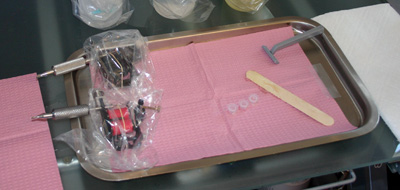SlingerVille Articles
 Health Risks of Getting a Tattoo
Health Risks of Getting a Tattoo
Article by: SlingerVille Staff
August 10, 2012
Health Risks of Getting a Tattoo
Putting a needle in your skin definitely has its health risks, and when you get tattooed you may think in the back of your head “man, I hope this place is sterile”.
While there are risks, the odds are in your favor that your artist is using clean needles and nothing will happen.
Health.HowStuffWorks.com has the following to say about health risks when getting a tattoo.
Health Risks:
Since tattoos involve needles and blood, they carry several risks. These include transmission of diseases like hepatitis, tuberculosis and possibly HIV. When tattoo artists follow all the correct sterilization and sanitation procedures, risks for disease transmission are relatively low. According to the Centers for Disease Control and Prevention (CDC), there has not been a documented case of HIV transmission from a tattoo. However, doctors warn that non-sterile tattooing practices can lead to the transmission of syphilis, hepatitis B and other infectious organisms.
Infections can occur in new tattoos, especially without appropriate aftercare. Some people also experience allergic reactions to tattoo inks. Although the pigments used may have U.S. Food and Drug Administration (FDA) approval for other purposes, the FDA does not regulate tattoo inks. Finally, some people experience pain or burning during magnetic resonance imaging (MRI) examinations because of metallic pigments. Some doctors have also reported interference and distorted MRI images from permanent makeup pigments.
In addition, most states place restrictions on whether people who have tattoos can donate blood. Because of the danger of hepatitis, the American Red Cross will not accept blood from someone who has been tattooed in the past year unless the tattoo parlor is state-regulated. Most states do not regulate tattoo parlors. [Source: American Red Cross]
Tattoo professionals use rules known as universal precautions to prevent the spread of illnesses during tattooing. These precautions are part of the Bloodborne Pathogens Rule issued by the U.S. Environmental Protection Agency (EPA). The same rules apply to hospitals and doctors' offices. The CDC is a good resource for information about universal precautions.
Other precautions specific to tattooing include:
• Checking gloves for pinhole tears during tattooing, since petroleum-based ointment erodes latex
• Pouring ink in advance, using clean tissue to open ink bottles during tattooing and preventing nozzles from touching contaminated surfaces
• Patting tubes dry after rinsing during color changes -- never blowing excess water from them
• Spraying liquid soap into a tissue, not directly onto bleeding area, since blood can become airborne when the spray hits it
• Giving pens used for drawing on the skin, which should be medical grade and sterile, to the client
•
Tattoo artists must also take special safety measures regarding their hands. Gloves help prevent disease transmission from bodily fluids, but bacteria thrive in the warm, damp environment they create. This means that artists must:
• Wash hands thoroughly and often
• Inspect hands for cuts or sores and cover them with bandages
• Remove hangnails and keep nails short to prevent punctures to gloves
• Refrain from tattooing when experiencing lesions, dermatitis or allergic reactions
Laws require minors to have a parent's permission to get a tattoo. So, some adolescents get tattoos from friends or amateurs, who use makeshift tools like pens and paper clips with little if any sanitary precautions. This is extremely dangerous, since proper equipment and sanitary measures protect people from disease and infection.
Source : http://health.howstuffworks.com/skin-care/beauty/skin-and-lifestyle/tattoo4.htm
Login to comment
Comments
No comments yet.

